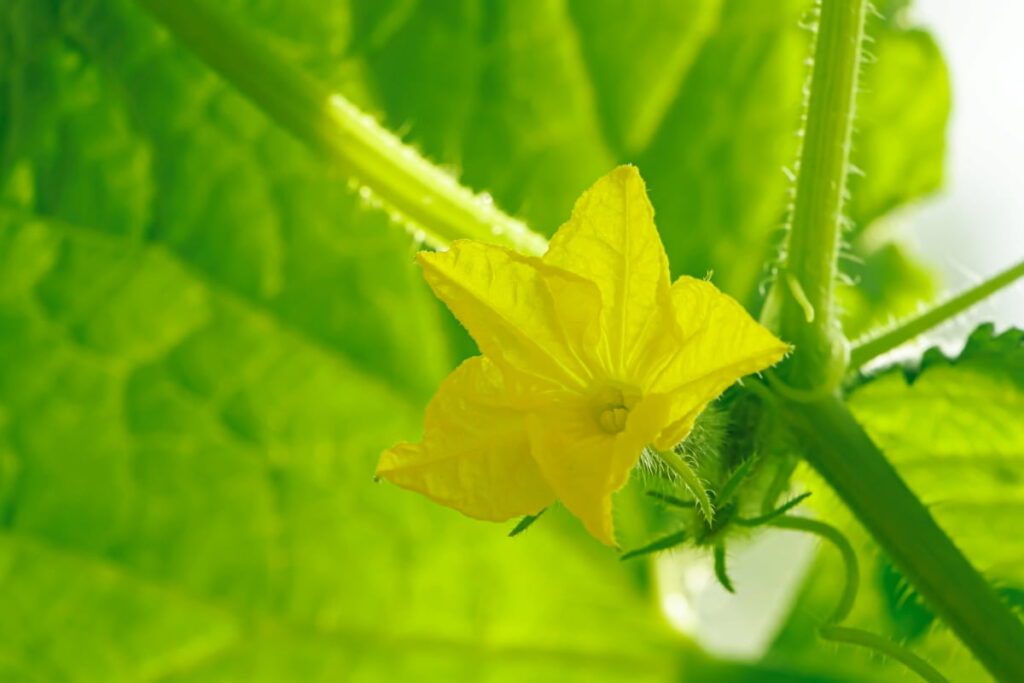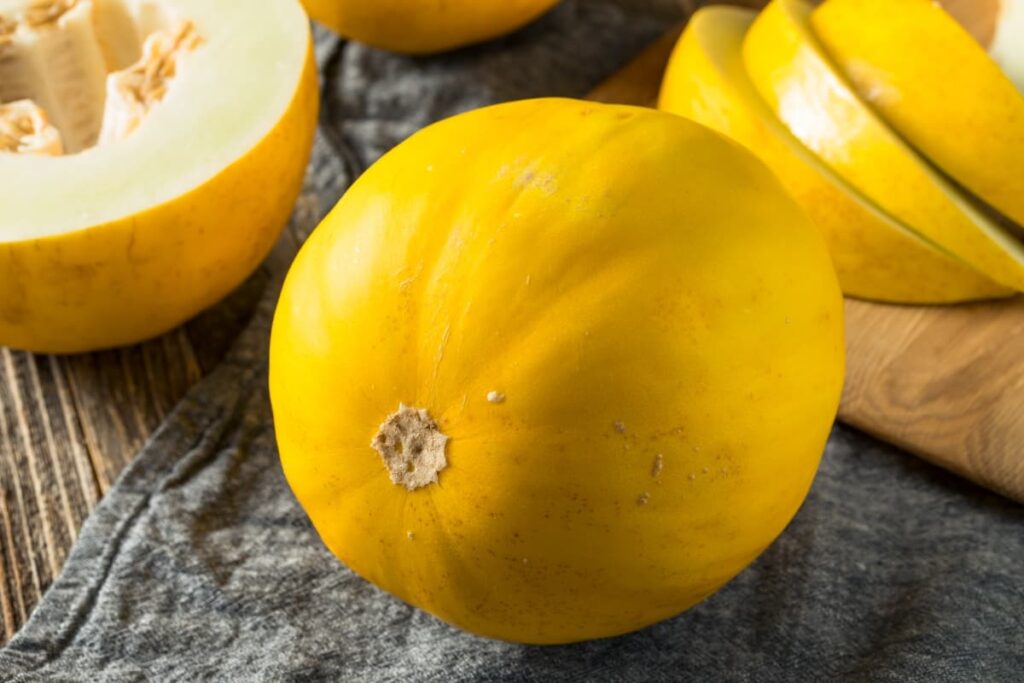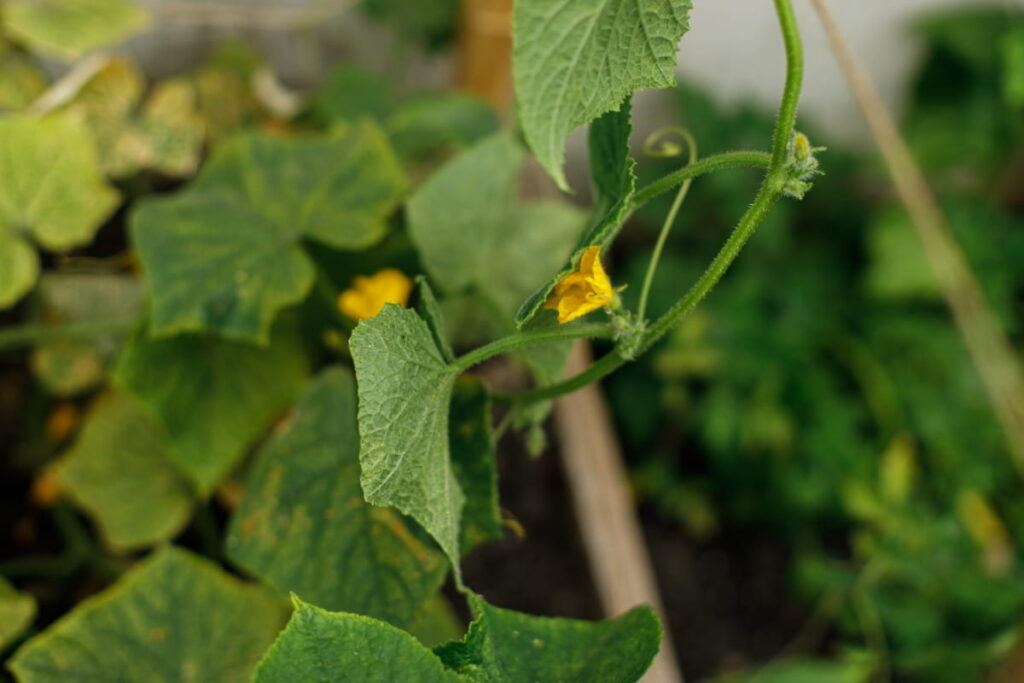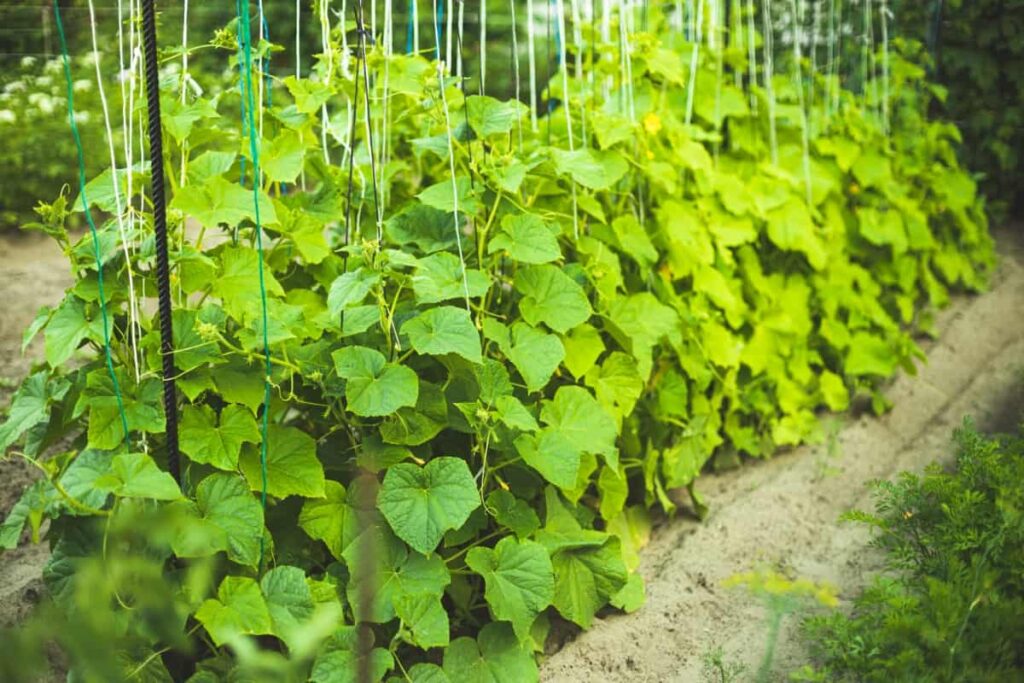Lemon Cucumber (Cucumis sativus ‘Lemon’) may not taste like lemons, but its vibrant yellow color and delicate skin make it a standout in the garden. Lemon Cucumbers are often referred to as lemon apples due to their appearance.

Grow Lemon Cucumbers
Unique Characteristics: The Lemon Cucumber belongs to the gourd family (Cucurbitaceae) and offers a milder flavor compared to regular cucumbers. With origins in the USA, this unique variety is sure to add flair to your garden and culinary creations. With their vibrant yellow color and round shape, they stand out from traditional cucumbers.
Historical Background and Cultivation: The history of Lemon Cucumbers dates back to the United States, where their cultivation began. Over time, this unique variety gained popularity for its refreshing taste and distinctive appearance. The cultivation of Lemon Cucumbers involves selecting high-quality seeds for optimal growth. Historically, Lemon Cucumbers have been cultivated for centuries, prized for their crisp texture and mild flavor.
Starting Your Lemon Cucumber Garden
Seed Selection and Germination: When choosing seeds, opt for high-quality organic ones to ensure a bountiful harvest. Look for cucumber varieties suited to your climate and growing conditions. When choosing Lemon Cucumber seeds, look for varieties that are disease-resistant and suited to your climate. Some popular Lemon Cucumber varieties include ‘Lemon,’ ‘Crystal Apple,’ and ‘Poona Kheera.’
Soil Preparation and Requirements: Next up, it’s time to prep your soil for those vibrant Lemon Cucumbers. Ensure the growing soil is rich in nutrients by adding compost or aged manure. Lemon Cucumbers thrive in slightly acidic soil with a pH level between 6.0 and 7.0.
Planting Lemon Cucumber
Best Time to Plant: The best time to plant Lemon Cucumber is in the late spring once the soil has warmed up and there’s no longer a risk of frost. Lemon Cucumbers thrive in warm weather, so make sure to wait until all danger of cold snaps has passed before getting them into the ground. This will give them the best chance at healthy growth and a bountiful harvest later on.
Planting Depth and Spacing: When it comes to planting your Lemon Cucumber seeds, depth and spacing are crucial for healthy growth. Plant your Lemon Cucumber seeds about 1 inch deep in well-draining soil and space them 12-18 inches apart, ensuring they have enough room to develop strong roots.
Indoor Start vs. Direct Sowing: If you choose to start growing Lemon Cucumber indoors, use biodegradable pots that can be planted into the ground once the seedlings are ready. This process allows for earlier planting and protection from outdoor elements. On the other hand, direct seed sowing involves planting seeds directly into the garden soil at the right time of year. Whether you opt for indoor starting or direct sowing, proper planting depth and spacing will set a solid foundation for your Lemon Cucumber plants’ growth journey.
In case you missed it: 19 Best Cucumbers for Pickling: Top Crunchy Varieties to Grow in Your Garden

Caring for Lemon Cucumber Plants
Watering Needs and Techniques: These veggies thrive in consistently moist soil, so water them regularly. However, do not overwater the Lemon Cucumber, as this can lead to root rot. One effective technique is to water your Lemon Cucumbers at the base of the plant rather than overhead. This helps prevent issues like powdery mildew and keeps the foliage dry. Remember that different factors, such as weather conditions and soil type, can affect how often you need to water your Lemon Cucumbers.
Fertilization and Soil Management: Fertilizing your Lemon Cucumber plants with organic matter like compost or well-balanced fertilizers can provide essential nutrients for vibrant fruits. Prepare your growing soil by mixing in some compost or organic matter to ensure that it’s nutrient-rich and well-draining.
Mulching and Weed Control: Mulching around your Lemon Cucumber plants helps retain moisture in the soil, suppresses weed growth, and regulates soil temperature. Regularly removing weeds by hand or using natural mulch barriers can prevent competition for nutrients and sunlight that may hinder plant growth.
Optimizing Growth Conditions
Sunlight and Temperature Requirements: Lemon Cucumbers thrive in full sun, so they receive 6-8 hours of direct sunlight daily. Maintaining the right temperature is key to healthy plant development. Lemon Cucumbers prefer warm temperatures between 21-29°C during the day and slightly cooler nights.
Protecting Plants from Extreme Weather: Protect your Lemon Cucumber plants from extreme weather conditions such as frost by covering them with row covers or bringing containers indoors during cold snaps. During hot summer days, provide some afternoon shade to prevent heat stress on the plants. Be mindful of sudden temperature changes and adjust accordingly to ensure optimal growth conditions for your Lemon Cucumbers.
Pest and Disease Control
Common Pests and Natural Predators: Some of the most common pests that can affect your Lemon Cucumber plants include aphids, spider mites, and cucumber beetles. These pesky critters can affect your plants if left unchecked. One natural way to combat these pests is by attracting beneficial predators to your garden. Ladybugs, lacewings, and praying mantises are all excellent allies in controlling pest populations naturally without the need for harmful chemicals.
Identifying and Managing Diseases: It is also crucial in ensuring the health of your Lemon Cucumber plants. Watch for signs of powdery mildew, bacterial wilt, or downy mildew, as these can quickly spread and damage your crop. By taking proactive measures to address pest infestations and disease outbreaks promptly, you can help safeguard your Lemon Cucumber plants and ensure a bountiful harvest.
Organic Pest Control Options: One effective method is companion planting – strategically placing herbs and flowers like basil, marigolds, and dill around your cucumber plants can deter common pests. Another organic pest control option is using homemade sprays made from ingredients like garlic, neem oil, or soap solution.
In case you missed it: How Do You Grow Cucumbers in a Greenhouse: A Step-by-Step Guide for Beginners

Pruning and Training
Benefits of Pruning Lemon Cucumbers: By removing excess foliage and branches, you allow more sunlight and airflow to reach the plant, promoting better fruit development. Additionally, pruning encourages the cucumber plant to focus its energy on producing quality fruits rather than wasting resources on unnecessary growth. It can also help control the plant size, making it easier to manage and harvest.
Training on Trellises and Supports: Training your Lemon Cucumber plants on trellises and supports is a vital step in ensuring their optimal growth and productivity. Regularly training your Lemon Cucumber vines on trellises or supports saves space and also prevents fruits from rotting on the ground. Additionally, training allows for better access during maintenance tasks like watering and pest control.
Harvesting Lemon Cucumber
Signs of Ripeness and Maturity: Look for signs of ripeness and maturity to ensure a flavorful yield. Gently squeeze the cucumber – if it feels firm but not rock-hard, it’s likely ready to be picked. Another indicator is the size; once they reach about 3 inches in diameter, they’re good to go. Harvesting regularly encourages more fruit production, so keep an eye out for ripe cucumbers every few days during peak season.
Harvesting Techniques; Harvesting Lemon Cucumbers is an exciting time for any gardener. To maximize your yield, it’s crucial to pick the fruits when they reach the right size and color. Look for firm cucumbers with a bright yellow hue, indicating ripeness. Gently cut the fruit from the vine to avoid damaging the plant.
Maximizing Yield and Continuous Harvest: For continuous harvest throughout the season, regularly check your plants for ripe cucumbers every few days. The more you harvest, the more productive your vines will be. Remember not to let any cucumbers overripen on the vine, as this can hinder further fruit production. By staying attentive to your Lemon Cucumber garden’s needs, you can enjoy a bountiful harvest all season long.
Troubleshooting Common Issues
Addressing Yellowing Leaves or Stunted Growth: If you notice yellow color leaves or stunted growth in your Lemon Cucumber plants, it could be a nutrient deficiency or overwatering signs. To address this issue, consider adjusting your fertilization routine and ensure proper drainage in the soil.
Solutions for Overabundant or Underwhelming Harvests: If you find yourself with an overabundance of Lemon Cucumbers or underwhelming harvests, it’s time to reassess your planting density and watering schedule. Thinning out overcrowded plants can improve air circulation and sunlight exposure, leading to healthier growth and higher yields.
In case you missed it: How to Start Cucumber Farming/Growing in Philippines: Check How this Guide Helps Beginners

Conclusion
Lemon Cucumbers are easy to grow and maintain, making them ideal for both beginner and experienced gardeners alike. Their high yield potential means you can enjoy a bountiful harvest throughout the growing season. Growing Lemon Cucumbers comes with a host of benefits that make it a rewarding addition to any garden.
- Effective Fish Pond Construction Techniques for Beginners
- Irrigation and Water Management in Pineapple Farming
- Blossom to Harvest: Mastering Flowering and Pollination in Papaya Farming
- Pig Fattening Essentials: From Selection to Sale for Beginners
- Raising Wagyu Cattle: A Complete Guide for Premium Beef Production
- Soil Types and Their Water Holding Capacity
- Optimizing Irrigation Schedules for Coconut Groves for Enhanced Yield
- Espresso Your Garden: Coffee Grounds for Healthier Acid-Loving Plants
- The Best Soil Mix for Snake Plants: How to Mix Your Own Snake Plant Soil
